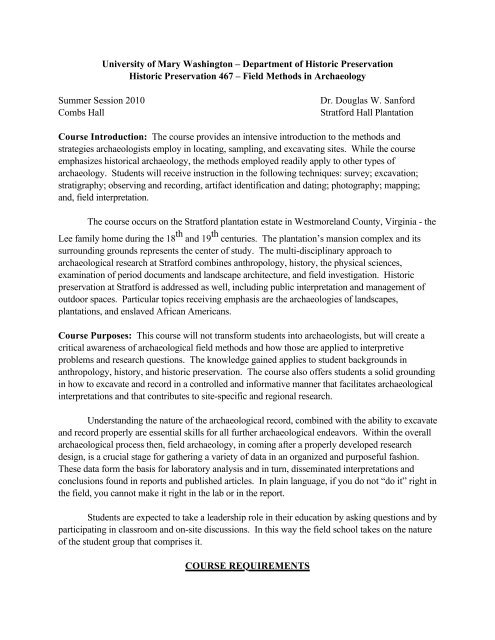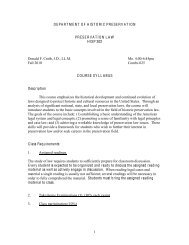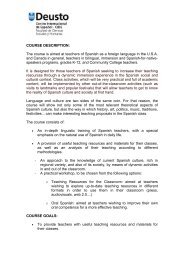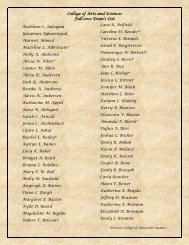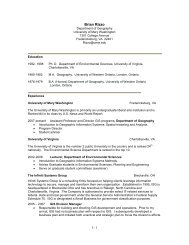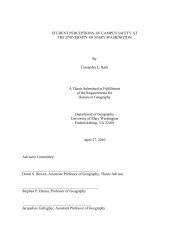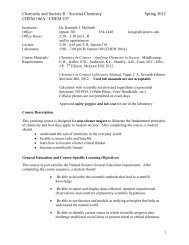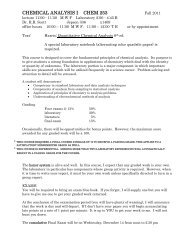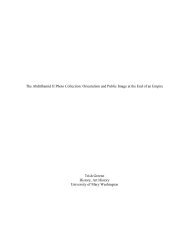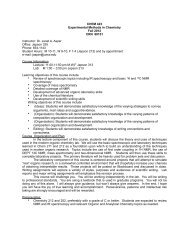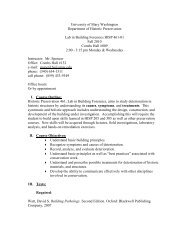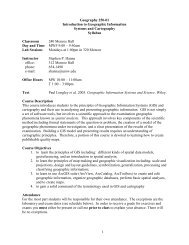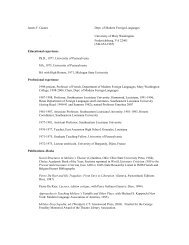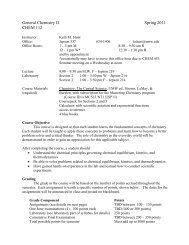Field Methods in Archaeology - College of Arts and Sciences
Field Methods in Archaeology - College of Arts and Sciences
Field Methods in Archaeology - College of Arts and Sciences
Create successful ePaper yourself
Turn your PDF publications into a flip-book with our unique Google optimized e-Paper software.
University <strong>of</strong> Mary Wash<strong>in</strong>gton – Department <strong>of</strong> Historic PreservationHistoric Preservation 467 – <strong>Field</strong> <strong>Methods</strong> <strong>in</strong> <strong>Archaeology</strong>Summer Session 2010Combs HallDr. Douglas W. SanfordStratford Hall PlantationCourse Introduction: The course provides an <strong>in</strong>tensive <strong>in</strong>troduction to the methods <strong>and</strong>strategies archaeologists employ <strong>in</strong> locat<strong>in</strong>g, sampl<strong>in</strong>g, <strong>and</strong> excavat<strong>in</strong>g sites. While the courseemphasizes historical archaeology, the methods employed readily apply to other types <strong>of</strong>archaeology. Students will receive <strong>in</strong>struction <strong>in</strong> the follow<strong>in</strong>g techniques: survey; excavation;stratigraphy; observ<strong>in</strong>g <strong>and</strong> record<strong>in</strong>g, artifact identification <strong>and</strong> dat<strong>in</strong>g; photography; mapp<strong>in</strong>g;<strong>and</strong>, field <strong>in</strong>terpretation.The course occurs on the Stratford plantation estate <strong>in</strong> Westmorel<strong>and</strong> County, Virg<strong>in</strong>ia - theLee family home dur<strong>in</strong>g the 18 th <strong>and</strong> 19 th centuries. The plantation’s mansion complex <strong>and</strong> itssurround<strong>in</strong>g grounds represents the center <strong>of</strong> study. The multi-discipl<strong>in</strong>ary approach toarchaeological research at Stratford comb<strong>in</strong>es anthropology, history, the physical sciences,exam<strong>in</strong>ation <strong>of</strong> period documents <strong>and</strong> l<strong>and</strong>scape architecture, <strong>and</strong> field <strong>in</strong>vestigation. Historicpreservation at Stratford is addressed as well, <strong>in</strong>clud<strong>in</strong>g public <strong>in</strong>terpretation <strong>and</strong> management <strong>of</strong>outdoor spaces. Particular topics receiv<strong>in</strong>g emphasis are the archaeologies <strong>of</strong> l<strong>and</strong>scapes,plantations, <strong>and</strong> enslaved African Americans.Course Purposes: This course will not transform students <strong>in</strong>to archaeologists, but will create acritical awareness <strong>of</strong> archaeological field methods <strong>and</strong> how those are applied to <strong>in</strong>terpretiveproblems <strong>and</strong> research questions. The knowledge ga<strong>in</strong>ed applies to student backgrounds <strong>in</strong>anthropology, history, <strong>and</strong> historic preservation. The course also <strong>of</strong>fers students a solid ground<strong>in</strong>g<strong>in</strong> how to excavate <strong>and</strong> record <strong>in</strong> a controlled <strong>and</strong> <strong>in</strong>formative manner that facilitates archaeological<strong>in</strong>terpretations <strong>and</strong> that contributes to site-specific <strong>and</strong> regional research.Underst<strong>and</strong><strong>in</strong>g the nature <strong>of</strong> the archaeological record, comb<strong>in</strong>ed with the ability to excavate<strong>and</strong> record properly are essential skills for all further archaeological endeavors. With<strong>in</strong> the overallarchaeological process then, field archaeology, <strong>in</strong> com<strong>in</strong>g after a properly developed researchdesign, is a crucial stage for gather<strong>in</strong>g a variety <strong>of</strong> data <strong>in</strong> an organized <strong>and</strong> purposeful fashion.These data form the basis for laboratory analysis <strong>and</strong> <strong>in</strong> turn, dissem<strong>in</strong>ated <strong>in</strong>terpretations <strong>and</strong>conclusions found <strong>in</strong> reports <strong>and</strong> published articles. In pla<strong>in</strong> language, if you do not “do it” right <strong>in</strong>the field, you cannot make it right <strong>in</strong> the lab or <strong>in</strong> the report.Students are expected to take a leadership role <strong>in</strong> their education by ask<strong>in</strong>g questions <strong>and</strong> byparticipat<strong>in</strong>g <strong>in</strong> classroom <strong>and</strong> on-site discussions. In this way the field school takes on the nature<strong>of</strong> the student group that comprises it.COURSE REQUIREMENTS
Read<strong>in</strong>gs <strong>and</strong> Equipment: There are no required texts. Required read<strong>in</strong>gs will be madeavailable through photocopies <strong>and</strong> are listed on the course syllabus. Students will be assignedresponsibility for present<strong>in</strong>g <strong>and</strong> discuss<strong>in</strong>g read<strong>in</strong>gs on a weekly basis (see the guidel<strong>in</strong>es/h<strong>and</strong>outfor discussions <strong>and</strong> talk with the <strong>in</strong>structor <strong>in</strong> advance). Discussions will contribute to students’grades <strong>and</strong> will occur at arranged times, typically Friday morn<strong>in</strong>gs.The only required equipment is a 3-r<strong>in</strong>g notebook (for field notes <strong>and</strong> h<strong>and</strong>outs) <strong>and</strong> a 5-<strong>in</strong>ch Marshalltown trowel.Daily Log/<strong>Field</strong> Journal: Students will ma<strong>in</strong>ta<strong>in</strong> a daily log similar <strong>in</strong> style <strong>and</strong> format to thosekept by archaeological site supervisors concern<strong>in</strong>g on-site activities <strong>and</strong> current <strong>in</strong>terpretations.Further discussion <strong>of</strong> the journal’s content will occur <strong>in</strong> class <strong>and</strong> <strong>in</strong> the field. This notebookshould accompany students dur<strong>in</strong>g all class hours <strong>and</strong> activities <strong>and</strong>, represents a critical aspect <strong>of</strong>the course (see Grad<strong>in</strong>g below).<strong>Field</strong> Hours: The normal workday on-site will be from 8 AM to 4 PM, with all studentsrema<strong>in</strong><strong>in</strong>g on-site until excavations are closed <strong>and</strong> tools <strong>and</strong> equipment are stored. Time will bearranged to accommodate field trips. Some even<strong>in</strong>g hours may be required for other events.<strong>Field</strong> Trips: Attendance is required for two scheduled field trips that provide opportunities to visitarchaeological sites <strong>and</strong> organizations <strong>in</strong> the regional vic<strong>in</strong>ity <strong>of</strong> Virg<strong>in</strong>ia <strong>and</strong> Maryl<strong>and</strong>. The fieldtrips typically occur <strong>in</strong> the course’s last two weeks.F<strong>in</strong>al Exam<strong>in</strong>ation: Given at the course’s end, the exam first <strong>in</strong>volves an oral discussion with the<strong>in</strong>structor concern<strong>in</strong>g topics relevant to the read<strong>in</strong>gs <strong>and</strong> discussions, <strong>and</strong> to <strong>in</strong>terpretations <strong>of</strong> theseason’s excavations. An artifact identification exercise also will comprise part <strong>of</strong> the exam<strong>in</strong>ation.Grad<strong>in</strong>g: The f<strong>in</strong>al grade is based on: (1) daily field work <strong>and</strong> participation (<strong>in</strong>formationexchanges, application <strong>of</strong> ga<strong>in</strong>ed knowledge) – [40%]; (2) archaeological quality <strong>of</strong> the journal –[30%]; (3) presentation <strong>of</strong> assigned read<strong>in</strong>g <strong>and</strong> participation <strong>in</strong> weekly discussions <strong>of</strong> read<strong>in</strong>gs –[20%]; <strong>and</strong>, (4) results <strong>of</strong> the f<strong>in</strong>al exam (oral discussion <strong>and</strong> artifact ID test – [10%].SCHEDULE & READINGSMay 17 – May 21: Stratford as a Site, L<strong>and</strong>scape, <strong>and</strong> Community. Go<strong>in</strong>g <strong>in</strong>to the <strong>Field</strong> &Gett<strong>in</strong>g to Know Dirt.Sanford: L<strong>and</strong>scape, Change, <strong>and</strong> Community at Stratford Hall Plantation: AnArchaeological <strong>and</strong> Cultural Perspective. Quarterly Bullet<strong>in</strong> <strong>of</strong> the Archeological Society <strong>of</strong>Virg<strong>in</strong>ia. 54(1):2-19 (1999).Stewart: “<strong>Field</strong>work Motivation <strong>and</strong> Design,” pp. 37-54 from <strong>Archaeology</strong>: Basic <strong>Field</strong><strong>Methods</strong> (2002).Montgomery: “Good Old Dirt” <strong>and</strong> “Sk<strong>in</strong> <strong>of</strong> the Earth,” pp. 1-25 from Dirt: The Erosion<strong>of</strong> Civilizations (2007).
May 24 – May 28: African American Society, Material Life, <strong>and</strong> L<strong>and</strong>scapes.Calhoun: Stratford’s African-American Community.Heath <strong>and</strong> Bennett: “The little Spots allow’d them”: The Archaeological Study <strong>of</strong>African-American Yards. Historical <strong>Archaeology</strong> 34(2):38-55 (2000).Samford: “Introduction,” pp. 1-22, from Subfloor Pits <strong>and</strong> the <strong>Archaeology</strong> <strong>of</strong> Slavery <strong>in</strong>Colonial Virg<strong>in</strong>ia (2007).THERE IS NO CLASS ON MONDAY, MAY 31 st – MEMORIAL DAYJune 1 – June 4: Record<strong>in</strong>g <strong>and</strong> Interpret<strong>in</strong>g the Archaeological Record.Stewart: “The Archaeological Record <strong>and</strong> the Recognition <strong>of</strong> Evidence,” pp. 19-35.Burke, Smith & Zimmerman: “F<strong>in</strong>d<strong>in</strong>g Sites,” pp. 67-94, from The Archaeologist’s<strong>Field</strong> H<strong>and</strong>book, North American Edition (2009).Kostro: “Excavat<strong>in</strong>g Sites Unseen: The Example <strong>of</strong> Earthfast Build<strong>in</strong>gs <strong>in</strong> the ColonialChesapeake,” pp. 183-199 from Between Dirt <strong>and</strong> Discussion: <strong>Methods</strong>, Methodology, <strong>and</strong>Interpretation <strong>in</strong> Historical <strong>Archaeology</strong>, edited by Steven N. Archer <strong>and</strong> Kev<strong>in</strong> M. Bartoy(2006).June 7 – June 11: (More) Dirt & Distribution; Slavery (part 2).Montgomery: “Westward Hoe,” pp. 115-144 from Dirt: The Erosion <strong>of</strong> Civilizations.O’Connell et al.: “Distribution <strong>of</strong> Refuse-Produc<strong>in</strong>g Activities at Hazda Residential BaseCamps: Implications for Analyses <strong>of</strong> Archaeological Site Structure,” pp. 61-76 from TheInterpretation <strong>of</strong> Archaeological Spatial Pattern<strong>in</strong>g, edited by Ellen M Kroll <strong>and</strong> T. Douglas Price(1991).Samford: “Subfloor Pits <strong>and</strong> Slavery <strong>in</strong> Colonial Virg<strong>in</strong>ia,” pp. 174-189.June 14 – June 18: Critiqu<strong>in</strong>g <strong>and</strong> Compar<strong>in</strong>g Past <strong>and</strong> Present Interpretations at Stratford.Armes: “The Second Master <strong>of</strong> Stratford,” pp. 88-113 from Stratford Hall: The GreatHouse <strong>of</strong> the Lees (1936).Sanford & Duncan: Stratford’s Chang<strong>in</strong>g L<strong>and</strong>scape—Com<strong>in</strong>g to Terms withComplexity <strong>in</strong> a Unified Space (2005).FINAL EXAMINATIONInstructor Information:@ home: Douglas W. Sanford: 540-373-9747@ Mary Wash<strong>in</strong>gton <strong>College</strong>: Office – Combs 133Dept. <strong>of</strong> Historic Preservation 540-654-1314e-mail: dsanford@umw.edu


